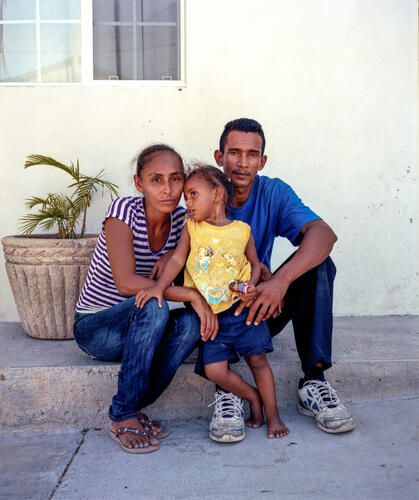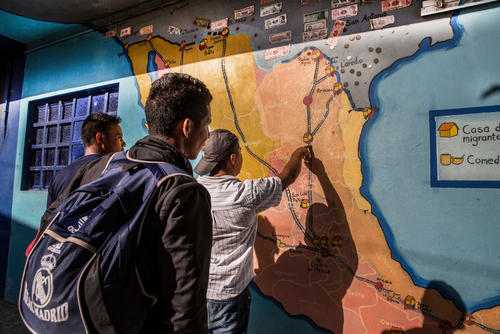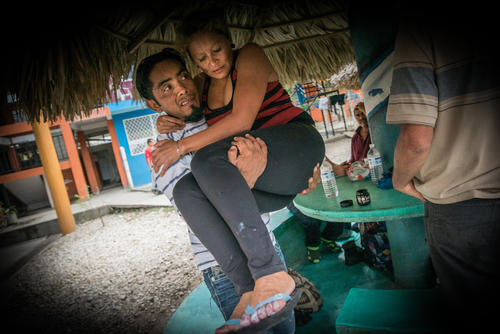Stephanie Puccetti, a humanitarian affairs advisor for MSF-USA, talks about the challenges facing migrants and asylum seekers in Honduras and Mexico, and along the US border.
Every year an estimated 500,000 people flee extreme violence and poverty in the Northern Triangle of Central America, which includes Honduras, El Salvador, and Guatemala. Despite catastrophic conditions in the region, the US and Mexico have focused efforts on detention and deportation rather than on providing safety and support. MSF teams offer medical and psychosocial care to displaced people in Central America and Mexico.
As part of a global team that represents MSF’s operations to key stakeholders - including governments, intergovernmental organisations, and other humanitarian groups - Stephanie works to ensure that those making decisions at the political and policy levels understand the implications for crisis-affected communities. By sharing perspectives from our staff in the field and from our patients, MSF aims to protect and expand the space for medical humanitarian action.
Why is the humanitarian crisis in Central America a priority for MSF? Aren’t there far worse conditions elsewhere in the world?
We have seen an increasing number of Central Americans fleeing horrific violence in their countries and undertaking a dangerous journey through Mexico in recent years.
MSF works in conflict-affected countries across the globe, and the experiences of our Central American patients are hauntingly similar to those whose lives have been uprooted by war.
In 2016, El Salvador and Honduras were ranked second and fourth worldwide, respectively, for the rate of violent death, joining Syria and Afghanistan in the top five.
We are concerned about the effects of this violence on the health and wellbeing of our patients, and the lack of protection and support services available to them. For MSF’s US office, this crisis hits particularly close to home.
We are urging the US government to fully recognise the humanitarian and international protection needs of Central American asylum seekers.Stephanie Puccetti, humanitarian affairs advisor
US refugee law provides legal protection to people in need of asylum. However, a decision this year by the US Attorney General to eliminate domestic violence and gang violence as legal grounds for asylum now endangers thousands of people facing legitimate, well-founded threats. This change almost universally bars Central Americans fleeing violence from seeking protection in the US.
It’s important to understand that asylum is different from other types of immigration, and provides vital protections for people fleeing violence and armed conflict. The right to seek asylum is guaranteed under domestic and international law.
We are urging the US government to fully recognise the humanitarian and international protection needs of Central American asylum seekers.

Is it feasible for people to stay in Mexico instead of coming to the US?
On paper, Mexican law offers some protections for asylum seekers, but in reality it is difficult for Central Americans to obtain legal asylum and adequate protections in Mexico.
Large parts of Mexico are dangerous, and Central American migrants are uniquely vulnerable to violence and extortion by criminal groups. Nearly 70 per cent of our migrant patients reported an incident of violence along the migration route; an incredible 33 per cent of women and 17 per cent of men reported an incident of sexual violence in Mexico.
Can you describe the specific conditions driving displacement in Honduras?
The nature of gang-based violence in Honduras is extremely targeted and personal - it can follow you throughout the country. We heard from families who were forcibly displaced four or five times before they made the difficult decision to cross the border. It’s not a choice people are making lightly. Leaving the country to seek asylum is often the only option for survival.
The Honduran government has acknowledged the crisis and estimates that around 200,000 people are internally displaced. Unofficial estimates place this number closer to half a million.
In other contexts with this number of displaced people, there are dozens of specialised non-governmental organisations and an established humanitarian response infrastructure. In Honduras, this expansive system does not exist. There is an active civil society and a few international organisations, but underfunding is a major issue. Many of the services we would expect to see in other crises of this scale are simply not available.
Nearly 70 per cent of our migrant patients reported an incident of violence along the migration routeStephanie Puccetti, humanitarian affairs advisor
Are there unique risks for people deported from the United States?
There are large numbers of people returned to Central America from the US who did not have legal status or whose asylum claims were rejected. If someone initially fled their home due to a threat on their life, that threat will likely still be there when they return. It can be difficult to find safety at home, so many people see no choice but to leave the country again.
Following the Trump administration’s decisions to revoke Temporary Protected Status (TPS) for Hondurans and Salvadorans living in the US, we are particularly concerned about the many thousands of people who will be forced to return to a country where they may be exposed to significant violence and separated from their protective social networks.

What are your upcoming priorities regarding Central America?
I’m working with our teams in Central America and Mexico to improve our regional analysis and develop a multi-country strategy for engagement.
I am also looking at the effects of US foreign policy on violence and displacement in Central America.
The US provides a significant amount of financial assistance to the region, and interventions are currently focused on addressing the root causes of migration, for example trying to improve economic and security conditions.
But this long-term approach ignores the immediate needs of vulnerable people who continue to face extreme violence and who have been forced from their homes. The US and other donors must provide greater support for urgent humanitarian assistance.
Témoignage - or bearing witness - is at the core of MSF’s mission. How do you balance this with other principles, such as impartiality and neutrality, when engaging at a political level?
MSF is known globally as an independent organisation that has a unique commitment to humanitarian principles.
We witness and share objective information about the effects of policies on our patients.
If we see that civilians are being harmed or a population doesn’t have access to medical care, regardless of which actor is responsible, we voice our concern and push for action.





